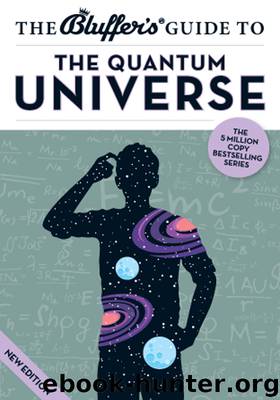The Bluffer's Guide to the Quantum Universe by Jack Klaff

Author:Jack Klaff
Language: eng
Format: epub
Publisher: Bluffer's Guides
Many people love Einstein as if he were their puppy.
Now, however smug it feels to have proved Einstein wrong and to show how spooky the cosmos really can be, you should not allow this to show. Firstly, it would be unseemly. Secondly, you would be hated for it; many people love Einstein as if he were their puppy. Thirdly and most importantly, the questions that Einstein posed and the doubts that he expressed have not completely gone away. You should never stop stating, gently, that quantum mechanics is incomplete. A situation that, needless to say, is being addressed daily – constantly – at Cern.
ORDER
It is worth noting, for conversations in which others do not mind getting technical, that all electrons are identical to each other, all protons are identical to each other, and all neutrons are identical to each other. In other words, three basic entities, by combining to form atoms, which combine again to form molecules, combine and combine again to build everything in the universe from bratwurst to battleships, from waffles to warthogs, from neck braces to New York. But it will also by now be clear that in every cubic millimetre of space there are billions and billions of subatomic particles which are capable of behaving at times in astonishing and unpredictable ways for no rhyme or reason. These repeatedly, spontaneously and ‘nuttily’ change their physical qualities, their whereabouts, their energies and their flight paths and, small as they are, seem to have the entire universe in tow. It is quite difficult to put them in neat piles, label them and file them away.
CLEAR DEFINITION
The point never stops being made, unfortunately, that particles that can clearly be defined as particles can also be found to have none of the qualities that are recognised as particle qualities; at such times they have all the qualities of waves and must be defined as waves. This is not a new idea, and yet the shock waves from it still do not seem to have subsided.
It challenges classical science, because clarity of definition is a cornerstone of science. It is almost the definition of it.
SEPARATENESS
Particles are often defined as ‘discrete’ (ibid.). This is a good word to use. ‘Discrete’ means ‘individually distinct’, ‘separate’. Holists believe that each particle tugs at and is tugged by the universe. Reductionists cannot quite budge from their stand of separateness and splendid isolation.
Whether you support one or the other (or neither), you need to concede that it is possible to study and conduct experiments with individual particles. Indeed, the ability to send a single electron whizzing through silicon is the very basis of the entire computer industry. (This fact should get good reactions. If people are receptive, it is good drama to add that computers, transistor radios, digital systems in TV, sound systems and even – pointing around the table at a sequence of wrists – digital watches, could not have been developed without quantum physics. Or you may prefer doing it the other way around, making computers the big finish.
Download
This site does not store any files on its server. We only index and link to content provided by other sites. Please contact the content providers to delete copyright contents if any and email us, we'll remove relevant links or contents immediately.
The Complete Stick Figure Physics Tutorials by Allen Sarah(7336)
Secrets of Antigravity Propulsion: Tesla, UFOs, and Classified Aerospace Technology by Ph.D. Paul A. Laviolette(5332)
Thing Explainer by Randall Munroe(3909)
The River of Consciousness by Oliver Sacks(3571)
The Order of Time by Carlo Rovelli(3162)
How To by Randall Munroe(3074)
A Brief History of Time by Stephen Hawking(2991)
I Live in the Future & Here's How It Works by Nick Bilton(2958)
What If?: Serious Scientific Answers to Absurd Hypothetical Questions by Randall Munroe(2667)
The Great Unknown by Marcus du Sautoy(2661)
Midnight in Chernobyl by Adam Higginbotham(2515)
Blockchain: Ultimate Step By Step Guide To Understanding Blockchain Technology, Bitcoin Creation, and the future of Money (Novice to Expert) by Keizer Söze(2466)
Networks: An Introduction by Newman Mark(2382)
The Meaning of it All by Richard Feynman(2318)
Easy Electronics by Charles Platt(2307)
The Tao of Physics by Fritjof Capra(2247)
Midnight in Chernobyl: The Untold Story of the World's Greatest Nuclear Disaster by Adam Higginbotham(2195)
When by Daniel H Pink(2098)
Introducing Relativity by Bruce Bassett(2097)
